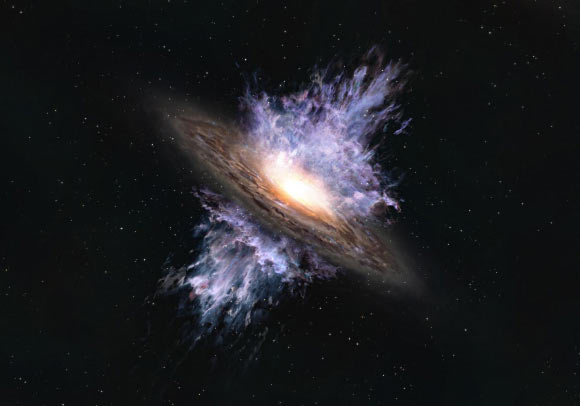
ALMA Detects Powerful Black-Hole Wind in Distant Quasar | Astronomy
Using the Atacama Large Millimeter/submillimeter Array (ALMA), astronomers have detected a galactic-scale supermassive black hole-driven wind in HSC J124353.93+010038.5 (J1243+0100 for short), a low-luminosity quasar seen as it was 13.1 billion years ago.An artists impression of a galactic wind driven by a supermassive black hole located in the center of a galaxy. Image credit: ALMA / ESO / NAOJ / NRAO.A supermassive black hole swallows a large amount of matter, said Dr. Takuma Izumi from the National Astronomical Observatory of Japan (NAOJ) and colleagues.As that matter begins to move at high speed due to the black holes gravity it emits intense energy, which can push the surrounding matter outward. This is how the galactic wind is created.The question is when did galactic winds come into existence in the Universe?This is an important question because it is related to an important problem in astronomy: how did galaxies and supermassive black holes coevolve?The astronomers used ALMA to observe the J1243+0100 galaxy, which was previously discovered by the Subaru Telescope.They captured radio waves emitted by the dust and carbon ions in the galaxy.The detailed analysis of the ALMA data revealed a high-speed gas flow moving at 500 km per second.This gas flow has enough energy to push away the stellar material in the galaxy and stop the star formation activity.The gas flow found in this study is truly a galactic wind, and it is the oldest observed example of a galaxy with a huge wind of galactic size.The previous record holder was a galaxy about 13 billion years ago; so this observation pushes the start back another 100 million years.The researchers also measured the motion of the quiet gas in J1243+0100, and estimated the mass of the galaxys bulge to be about 30 billion solar masses.The mass of the galaxys supermassive black hole, estimated by another method, was about 1% of that.The mass ratio of the bulge to the supermassive black hole in this galaxy is almost identical to the mass ratio of black holes to galaxies in the modern Universe.This implies that the coevolution of supermassive black holes and galaxies has been occurring since less than a billion years after the birth of the Universe.Our observations support recent high-precision computer simulations which have predicted that coevolutionary relationships were in place even at about 13 billion years ago, Dr. Izumi said.We are planning to observe a large number of such objects in the future, and hope to clarify whether or not the primordial coevolution seen in this object is an accurate picture of the general Universe at that time.The findings were published online in the Astrophysical Journal._____Takuma Izumi et al. 2021. Subaru High-z Exploration of Low-luminosity Quasars (SHELLQs). XIII. Large-scale Feedback and Star Formation in a Low-luminosity Quasar at z = 7.07 on the Local Black Hole to Host Mass Relation. ApJ 914, 36; doi: 10.3847/1538-4357/abf6dc
……Other
Comments
Leave a comment in Nestia App